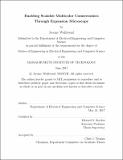Enabling scalable multicolor connectomics through expansion microscopy
Author(s)
Wohlwend, Jeremy
DownloadFull printable version (4.205Mb)
Other Contributors
Massachusetts Institute of Technology. Department of Electrical Engineering and Computer Science.
Advisor
Edward S. Boyden.
Terms of use
Metadata
Show full item recordAbstract
Decades of work in computational power and high resolution imaging have made it possible to observe specific neurons and their connections at a microscopic level. This level of resolution is known as the connectomic level. While we have been able to observe the brain at such resolution for some time thanks to electron microscopy (EM), the analysis of the resulting data has proven to be a very challenging task, mainly because it relies only on membrane contrast to differentiate cells. Expansion microscopy (ExM) offers an exciting alternative to EM by expanding physical brain tissue, with the added benefits that regular optical microscopes can be used for image acquisition. This will enable a faster, cheaper, and multicolor approach to connectomics, and may have the potential to realistically tackle a nervous system as large and complex as a mammalian brain. Currently, the study and the development of Expansion Microscopy are limited by the rate at which experiments run, which can take weeks, and sometimes months. In a previous project, we described a pipeline to create synthetic ExM images (SimExM) and discussed the importance of ground truth data in experimenting with segmentation algorithms. One of the main bottlenecks in creating a full connectome is the need for these ground truth annotations which require a substantial amount of manual work. This work explores various reconstruction strategies based on ExM. We evaluate their dependency on manual annotations and their overall performance, and contribute, as such, to the development of a scalable connectomics pipeline.
Description
Thesis: M. Eng., Massachusetts Institute of Technology, Department of Electrical Engineering and Computer Science, 2017. This electronic version was submitted by the student author. The certified thesis is available in the Institute Archives and Special Collections. Cataloged from student-submitted PDF version of thesis. Includes bibliographical references (pages 49-51).
Date issued
2017Department
Massachusetts Institute of Technology. Department of Electrical Engineering and Computer SciencePublisher
Massachusetts Institute of Technology
Keywords
Electrical Engineering and Computer Science.